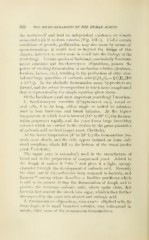Page 372 - My FlipBook
P. 372
344 THE MICRO-ORGANISMS OF THE HUMAN MOUTH.
tlie iiiotlier-cell and lead an independent existence, or remain
connected with it to form colonies (Fig. 123 a). Under certain
conditions of growth, proliferation may also occur l)y means of
spore-formation ; it woitM lead us beyond the design of this
chapter, however, to enter more in detail into the biology of the
yeast-fungi. Certain species of bud-fungi, particularly Saccharo-
myces cerevisiie and Saccharomyces ellipsoideus, possess the
power of exciting fermentation in saccharine solution (dextrose,
levulose, lactose, etc.), resulting in the production of ethyl alco-
hol and large quantities of carbonic acid (CgHijOg = 2 CjH^HO
-f 2 CO2). In the alcoholic fermentation many by-products are
formed, and the actual decomposition is much more complicated
than is represented by the simple equation given above.
Of the best-known and most important yeast-fungi I mention :
1. Saccharomyces cerevisise (Cryptococcus cer.), round or
oval cells, 8 to 9/i long, either single or united to colonies;
used in beer breweries and bread bakeries. At the higher
temperature at which beer is brewed (18° to 20° C.) the fermen-
tation progresses rapidly, and the yeast forms large branching
colonies which are carried to the surface by the great quantities
of carbonic acid evolved (upper yeast, Oberhefe).
At the lower temperature (4° to 10° C.) the fermentation pro-
ceeds more slowly, and the cells appear isolated or form only
small complexes which fall to the bottom of the vessel (under
3-east, Unterhefe).
The upper yeast is extensively used in the manufacture of
bread and in the preparation of compressed yeast. Added to
the dough it makes it " rise," and gives it a light, spongy
character through the development of carbonic acid. Recently
the chief part in this action has been assigned to bacteria, and
Laurent^* among others describes a Bacillus panificans which
is said to be present during the fermentation of dough and to
produce the necessary carbonic acid ; others again claim that
bacteria first convert the starch into sugar, which is then further
decomposed by the yeast into alcohol and carbonic acid.
2. Saccharomyces ellipsoideus, wine-yeast
: elliptical cells, 6//
long, single, or in small branched colonies, very widespread in
nature, chief cause of the spontaneous fermentations.


